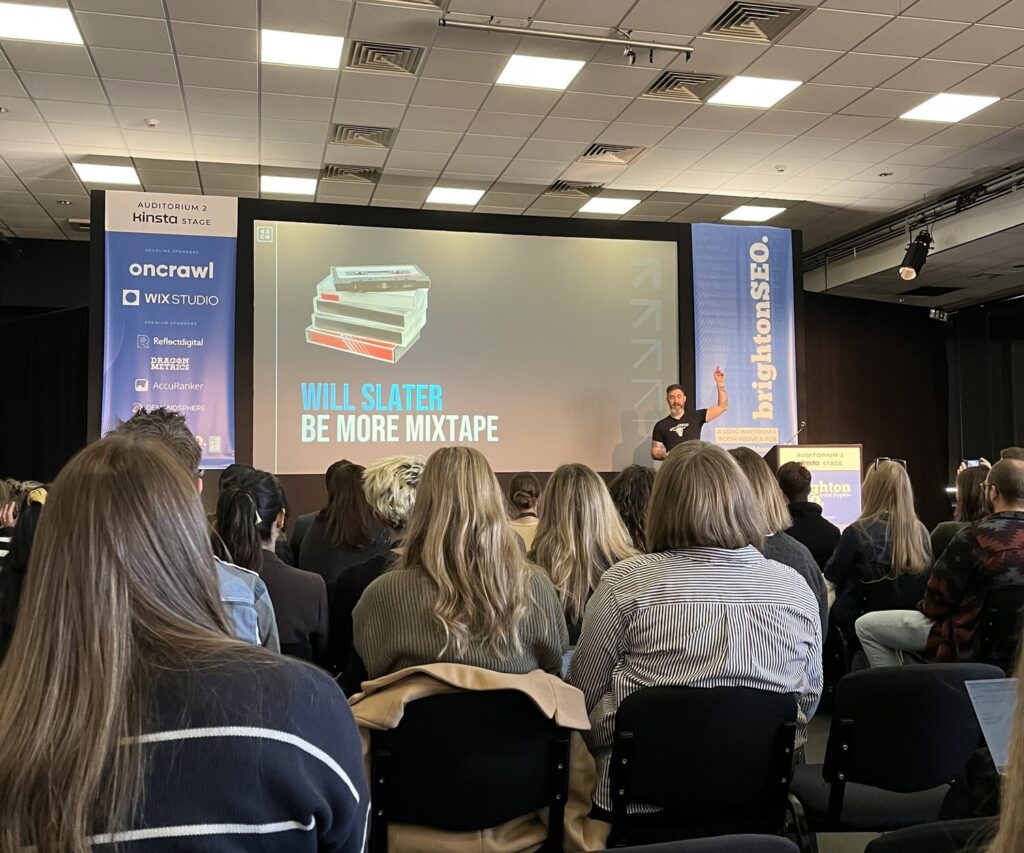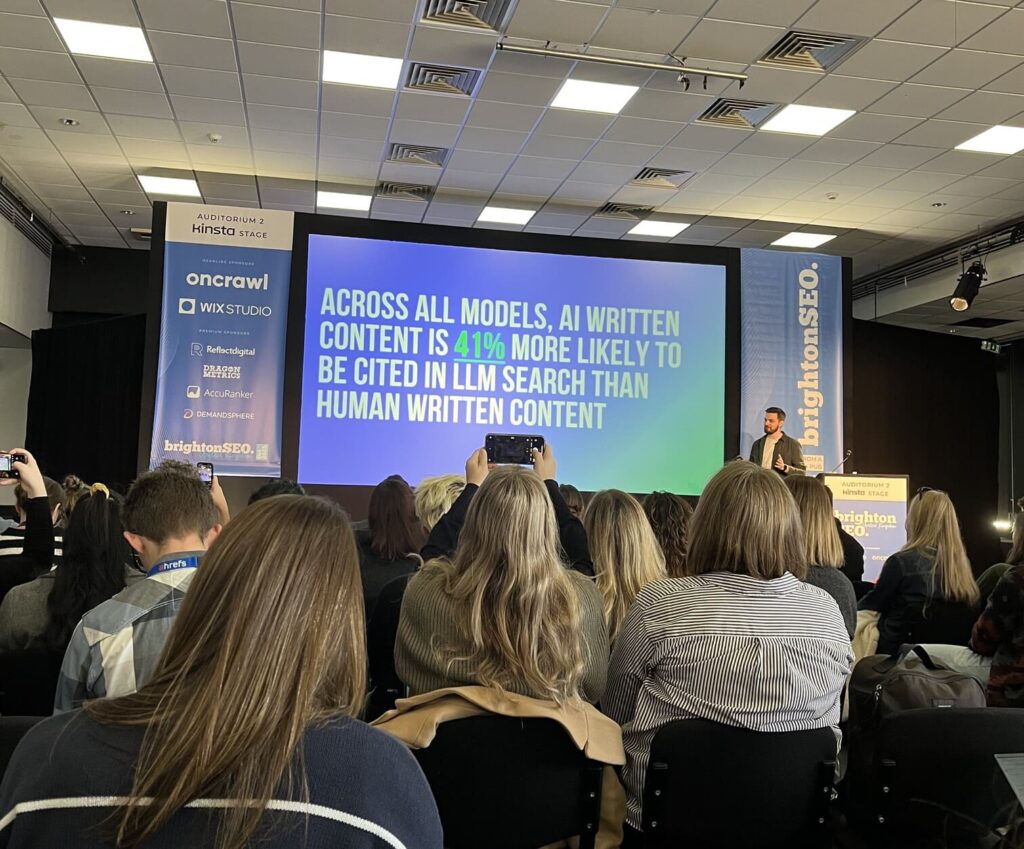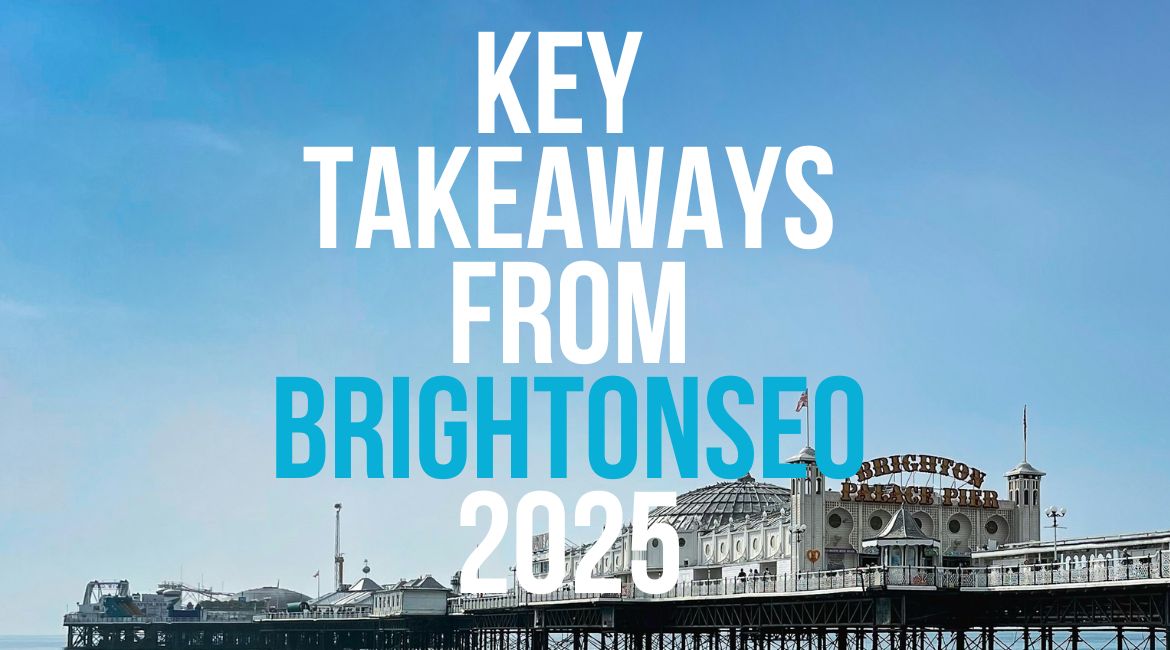The impact of Large Language Models (LLMs) on SEO and the importance of brand building in the AI era were the core themes running through BrightonSEO October 2025.
How is AI impacting SEO? How can AI be used in SEO? How do we react to the increase in zero click searches? The answers all lie with integrated digital marketing and brand building.

Be more mixtape: why you shouldn’t use AI to write
Friday at BrightonSEO started on the right note with Will Slater of 43 Clicks North’s plea to take an old school, hand-curated approach to content.
In the same way that Spotify curates playlists that are boring and samey, the reason AI content is so bland and generic is because LLMs are learning from their own content.
So how do we fight back against the 60,000 AI articles that are published every day?
With a handmade mixtape approach. With enough music references to warm the hearts of every music nerd, Will underlines the value of human written content.
AI has no lived experience, it doesn’t have critical or analytical thinking capabilities, which are essential to creating content that people actually want to read.
Writing is thinking – the process of writing is just as important as the final piece – because the finished piece isn’t always what you had planned.
Standout quote
“Semantic chunking* makes me want to hurl chunks”

Can you scale LLM traffic through AI?
With the audience powered up and ready to defend human content to the end, the crux of Ed Coles’ talk was somewhat disheartening.
Kaizen’s research set out to test whether there are any benefits of using AI written content in SEO and AI strategies.
While there has been a 527% increase in LLM traffic this year to date, it is still a very small proportion of search traffic overall. In fact, less than 1% of traffic is being driven by LLMs.
But, LLMs provide a much higher conversion rate compared to organic search.
Kaizen’s research shows a conversion rate that is 12 times higher than organic search, with average session duration five times higher than that of organic traffic.
AI content vs. human content
Its research compared AI and human content to learn which gained the most impressions and clicks in search engines and LLMs. So, what was the result?
Across all LLM models, AI written content is 41% more likely to be cited in LLM search than human content.
Ouch. Not the result we were hoping for.
What that tells us is that LLMs are not currently as fussy about content as Google and other search engines – yet! – so they are more likely to cite AI content.
But let’s remember, Google wasn’t particularly fussy in its early days either.
Its algorithms have become much more sophisticated over time and LLMs most likely will too.
So, if you’re tempted to dive right into using AI for content generation without considering the bigger picture then you could be setting your brand up to fail.
Why there? The psychology of search behaviour
Becky Simms of Reflect Digital opened our eyes to the value of utilising behavioural psychology in search strategy, urging us to think more about why and where users search, not just what they search.
There are four main drivers of search behaviour, which drive audiences to different platforms for the information that they need:
- Fact-finding for rational, objective information
- Crowd-sourcing for validation from peers and communities
- Taste-tuning to find inspiration that fits an identity
- Habit-driven shortcuts based on trust and familiarity
For example, under 44s use five platforms to search and social media is currently second to search, so your search strategy should be evolving to reflect this type of behaviour.
But remember that this is one audience type and your strategy should consider the behaviour of your target audience.
There are certain platforms that naturally group together during the user journey based on their needs and motivations, such as social and search platforms.
Learn where your audience go for inspiration and education, and when they want written or multimedia content, to better connect with potential customers.
The exposure effect
Becky also explained how we should utilise the exposure effect in psychology.
We have a natural preference for things that are more familiar to us, which underlines the importance of integrated marketing if we are to use this behaviour to our advantage.
Brand, search & social – a search everywhere trifecta
Up until recently, search was platform. Search referred exclusively to search engines and more often than not, Google.
Search has now become a behaviour that is spread across multiple platforms, Ashley Liddell of Deviation explained, with 89% of buyers researching across three platforms before purchase (McKinsey & Company).
Typical search behaviour now includes a combination of search engines, AI tools, social media and forums to find answers, products and brands that can be trusted.
What does this mean for brands? You have limited brand discovery if you’re not combining brand with social and SEO, as content is now experienced across multiple channels.
SEO teams can support brand teams by using data on search behaviour and trends to help inform campaigns that work across channels.
Brand search
Digital marketing is no longer about creating visibility, it’s about using an integrated approach to create preference.
In 2026, search will look different for everyone, so you need users to be searching for your brand.

Key takeaways from BrightonSEO October 2025
- AI and LLM search is still in its infancy, meaning brands have the opportunity to get ahead of competitors and make themselves visible in this space.
- An integrated approach to marketing has never been more important. Your potential customers are searching across multiple platforms to find answers, products, services and trust signals.
- Use different platforms to reflect how customers utilise those different touch points – understand where they go for inspiration (TikTok and Instagram) vs. where they go for validation (Reddit and Tripadvisor).
- Don’t just create content that gets you seen in search engines and LLMs, create content that users want to read, watch and share.
- Create content that gets you remembered and supports brand awareness across all the channels your audience is using.
- Becoming visible in AI should be a priority for brands planning their 2026 strategies, but don’t take short cuts if you want to achieve great results.
Are you wondering how to keep up in the ever-changing organic and social search space? Find out how we can support your business with SEO and social media marketing, or contact our team.
*Structuring content by topic to increase visibility in AI tools




